Horror comedian movies are a unique blend of genres that offer a thrilling and hilarious cinematic experience. They masterfully weave chilling moments with side-splitting humor, leaving audiences both terrified and entertained. This list delves into the top 10 best horror comedies, exploring their unique blend of fear and laughter.
10. Jennifer’s Body (2009)
- Director: Karyn Kusama
- Synopsis: After being possessed by a demon, a popular high school cheerleader becomes a flesh-eating succubus, targeting her male classmates while her best friend attempts to stop her.
- Why it’s great:
- Feminist themes: The film tackles themes of female sexuality, friendship, and the objectification of women in a subversive and thought-provoking manner.
- Sharp wit: The dialogue is witty and sharp, filled with dark humor and social commentary.
- Stylish visuals: The film is visually stylish, with a distinct aesthetic that complements the dark and comedic tone.
Jennifer’s Body: A Deeper Dive into a Modern Horror Classic
Karyn Kusama’s 2009 film, Jennifer’s Body, is a dark comedy horror flick that initially struggled to find its audience but has since garnered a cult following. It’s a film that subverts expectations, tackles complex themes of female sexuality, and features a killer soundtrack.
A Twisted Tale of Friendship and Possession:
The film centers around two best friends:
- Needy (Amanda Seyfried): The “normal” one, the observer, the voice of reason.
- Jennifer (Megan Fox): The popular, effortlessly cool one, the object of male desire.
Their idyllic high school existence is shattered when Jennifer, during a disastrous date with a local rock band, is sacrificed to a demon. The ritual transforms her into a succubus, a creature that feeds on the life force of men.
More Than Just a Teen Scream Queen:
Jennifer’s Body is not your typical teen horror movie. It’s a film that explores:
- Female sexuality and desire: Jennifer, initially objectified by the male gaze, becomes a force of nature, subverting the traditional role of the female victim. She embodies both the allure and the danger of female sexuality, challenging societal expectations.
- Female friendship: The core of the film lies in the complex and evolving relationship between Needy and Jennifer. Their friendship is tested by Jennifer’s transformation, forcing Needy to confront her own insecurities and ultimately choose between loyalty and self-preservation.
- Social commentary: The film satirizes the objectification of women in popular culture, the dangers of toxic masculinity, and the pressures faced by young women to conform to societal norms.
A Visual Feast:
Jennifer’s Body is visually striking, with a distinct style that blends dark humor, vibrant colors, and a touch of the grotesque. Director Karyn Kusama crafts a visually arresting world that perfectly complements the film’s unique tone.
Why it Resonates:
- Subversive and Unpredictable: The film defies genre conventions, offering unexpected twists and turns that keep viewers engaged.
- Sharp Dialogue: Diablo Cody’s witty and often darkly humorous script is filled with memorable lines and insightful observations about teenage life.
- Strong Performances: Megan Fox delivers a captivating performance as the conflicted and increasingly monstrous Jennifer, while Amanda Seyfried provides a grounded and relatable portrayal of Needy.
- Timeless Themes: The film’s exploration of female sexuality, friendship, and societal pressures remains relevant and resonates with audiences today.
Jennifer’s Body may not have been an immediate box office success, but it has gained a loyal following over the years. It’s a film that rewards repeat viewings, revealing new layers of meaning with each watch.
Disclaimer: This analysis provides a deeper dive into the film’s themes and significance. It is intended for mature audiences as the film contains mature content, including violence and strong language.
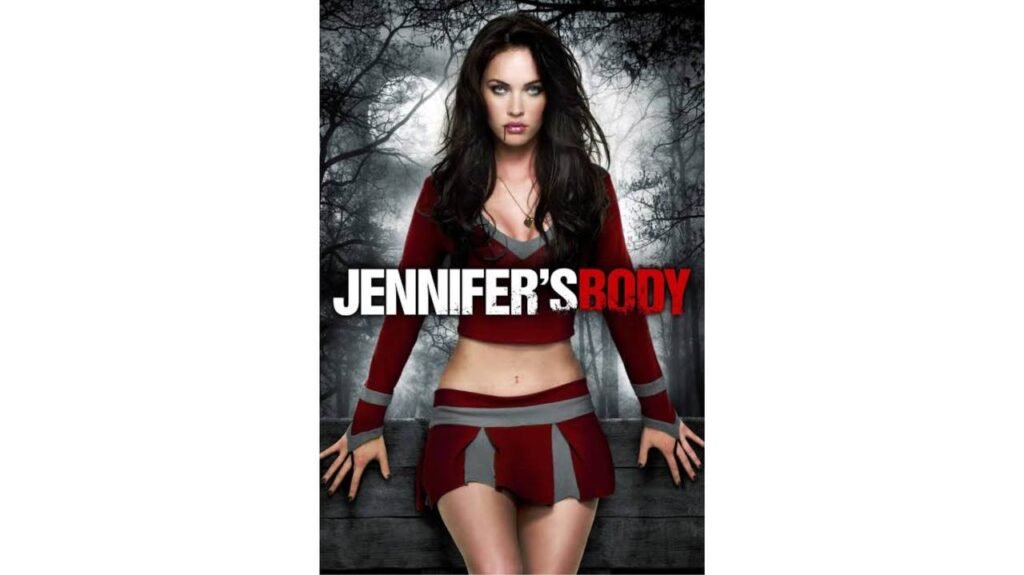
9. The Return of the Living Dead (1985)
- Director: Dan O’Bannon
- Synopsis: A group of medical students accidentally release a deadly virus that turns the dead into flesh-eating zombies, leading to a chaotic and hilarious battle for survival.
- Why it’s great:
- Black humor: The film features dark and often morbid humor, pushing the boundaries of good taste while remaining consistently entertaining.
- Influential: The Return of the Living Dead is a highly influential film, introducing the concept of “zombie rules” and influencing countless horror films that followed.
- Cult following: The film has developed a dedicated cult following, with fans appreciating its unique blend of horror, comedy, and punk rock aesthetics.
The Return of the Living Dead (1985): A Deep Dive into a Cult Classic
The Return of the Living Dead (1985), directed by Dan O’Bannon, is a groundbreaking horror-comedy film that redefined the zombie genre. It’s a darkly humorous, gore-filled, and surprisingly philosophical exploration of the undead, leaving a lasting impact on popular culture.
Plot:
The film revolves around Freddy, a new employee at a medical supply warehouse. While exploring the facility with his boss, Frank, they stumble upon a secret military experiment: canisters containing a nerve gas designed to reanimate the dead. Accidentally releasing the gas, they unleash a horde of ravenous zombies upon the unsuspecting city of Louisville.
As the zombie outbreak spreads, Freddy, Frank, and their friends, a group of punk rock teens, must fight for survival against the relentless undead. The film takes a unique approach to zombie lore, establishing that zombies crave brains, not just flesh, and that they can be killed by acid.
Key Elements and Impact:
- Subverting Zombie Tropes: Before The Return of the Living Dead, zombies were primarily slow-moving, shambling creatures. This film introduced fast-moving, agile zombies with a distinct hunger for brains, significantly influencing subsequent zombie films.
- Dark and Disturbing Humor: The film blends horror with dark, often morbid humor, pushing the boundaries of good taste. The dialogue is sharp, witty, and filled with cynical observations about life and death.
- Punk Rock Aesthetic: The film’s punk rock soundtrack and rebellious teenage characters contributed to its unique style and resonated with a specific audience.
- Cultural Impact: The Return of the Living Dead has achieved cult classic status, influencing countless horror films and spawning a franchise of sequels. It’s remembered for its iconic imagery, memorable characters, and its subversive take on the zombie genre.
Memorable Characters and Performances:
- Freddy: Played by Thom Mathews, Freddy is the hapless protagonist who accidentally unleashes the zombie apocalypse. He undergoes a transformation throughout the film, from a naive newcomer to a resourceful survivor.
- Frank: Portrayed by James Karen, Frank is Freddy’s gruff but ultimately caring boss. He provides a touch of comic relief and a surprising amount of wisdom.
- Tarman: A memorable zombie character with a grotesque appearance and a penchant for speaking. Tarman’s lines, such as “Send more paramedics!” and “More brains!” have become iconic.
Technical Aspects:
- Visual Effects: The film features impressive practical effects, creating gruesome and memorable zombie make-up and gore. The filmmakers skillfully blended practical effects with stop-motion animation for some of the more grotesque moments.
- Soundtrack: The punk rock soundtrack, featuring bands like The Cramps, The Damned, and Roky Erickson, perfectly complements the film’s rebellious and anarchic tone.
Legacy:
The Return of the Living Dead remains a significant milestone in horror cinema. It redefined the zombie genre, introduced new tropes, and pushed the boundaries of horror comedy. Its influence can be seen in countless films that followed, solidifying its place as a cult classic and a must-see for any fan of horror.

8. Army of Darkness (1992)
- Director: Sam Raimi
- Synopsis: Ash Williams, the chainsaw-handed hero from The Evil Dead, is transported back in time to the medieval era, where he must battle a horde of undead and reclaim the Necronomicon.
- Why it’s great:
- Over-the-top action: The film is packed with over-the-top action sequences, featuring brutal violence and hilarious physical comedy.
- Bruce Campbell: Bruce Campbell delivers a charismatic and iconic performance as Ash, embodying the film’s blend of horror and humor.
- Cult classic: Army of Darkness has achieved cult classic status, with fans appreciating its unique blend of horror, comedy, and fantasy.
Army of Darkness: A Deeper Dive into the Groovy Horror-Comedy
Army of Darkness (1992), the third installment in Sam Raimi’s Evil Dead trilogy, is a cult classic that seamlessly blends horror with over-the-top action and side-splitting humor. This film, starring the iconic Bruce Campbell as Ash Williams, catapulted the character to legendary status and cemented Raimi’s reputation as a visionary filmmaker.
A Time-Traveling Mishap:
Picking up where Evil Dead II left off, Ash finds himself inexplicably transported back to the medieval era. Armed with his trusty chainsaw hand and a witty arsenal of one-liners, he must navigate this unfamiliar world, filled with knights, castles, and, of course, the undead.
Facing the Deadites and Himself:
Ash quickly discovers that he’s the prophesied “The Chosen One,” destined to retrieve the Necronomicon Ex-Mortis (the Book of the Dead) and defeat the evil forces that plague the land. However, his modern sensibilities clash with the medieval mindset, leading to hilarious cultural misunderstandings and chaotic encounters.
The “Hail to the King, Baby!” Moment:
Perhaps the most iconic scene in the film, Ash’s triumphant declaration of “Hail to the King, Baby!” after successfully reciting the incantation to raise an army of skeletons, has become a beloved pop culture reference. This moment perfectly encapsulates the film’s blend of horror, comedy, and over-the-top action.
A Battle for Survival (and Sanity):
Ash faces numerous obstacles in his quest, including:
- The Deadites: An army of undead creatures, including skeletons, demons, and the fearsome Deadite warriors, constantly threaten Ash’s survival.
- Medieval Misconceptions: Ash’s modern slang and behavior are met with confusion and suspicion by the medieval villagers.
- “Evil Ash”: Ash’s own ego and arrogance lead to the creation of a doppelganger, a malevolent version of himself that threatens to unleash even greater chaos.
A Visual Feast:
Army of Darkness is a visual spectacle, featuring:
- Innovative Practical Effects: Raimi and his team utilized impressive practical effects, creating memorable and gruesome creatures and environments.
- Dynamic Camera Work: The signature fast-paced editing and dynamic camera work, characteristic of Raimi’s style, create a sense of energy and excitement.
- Over-the-Top Action Sequences: The film is packed with thrilling action sequences, including sword fights, chainsaw duels, and epic battles against hordes of the undead.
A Cult Classic Legacy:
Army of Darkness has achieved cult classic status, beloved by fans for its:
- Unique Blend of Genres: The film’s masterful blend of horror, comedy, and action creates a unique and unforgettable cinematic experience.
- Iconic Performances: Bruce Campbell’s charismatic performance as Ash is a highlight, delivering witty one-liners and over-the-top physical comedy.
- Enduring Popularity: The film continues to entertain and inspire audiences with its quotable lines, memorable characters, and timeless humor.
Beyond the Film:
Army of Darkness has spawned a comic book series, video games, and even a television series, Ash vs Evil Dead, further expanding the adventures of Ash Williams and solidifying his place in pop culture history.
Conclusion:
Army of Darkness is a groundbreaking film that redefined the horror-comedy genre. Its blend of over-the-top action, witty humor, and iconic performances has ensured its place as a cult classic. The film’s enduring popularity is a testament to its unique and unforgettable cinematic experience.
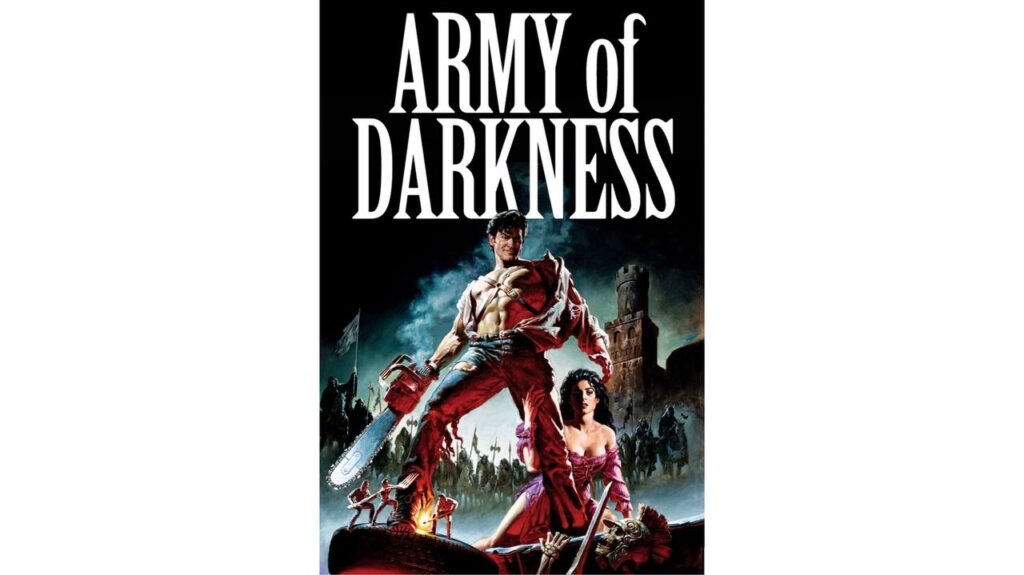
7. What We Do in the Shadows (TV Series)
- Creators: Jemaine Clement, Taika Waititi
- Synopsis: The hilarious adventures of four vampires sharing a flat in Staten Island, New York, as they navigate modern life, deal with existential crises, and try to maintain their undead existence in the 21st century.
- Why it’s great:
- Consistent quality: The series maintains the high-quality humor and sharp writing of the film, delivering consistently funny and engaging episodes.
- Character development: The characters are further developed, exploring their backstories and relationships in greater depth.
- World-building: The series expands the vampire world, introducing new characters and locations, while staying true to the original film’s tone and humor.
What We Do in the Shadows (TV Series): A Deeper Dive
What We Do in the Shadows is an American comedy horror mockumentary television series that premiered on FX on March 27, 2019. It is based on the 2014 New Zealand film of the same name, co-written and directed by Jemaine Clement and Taika Waititi, who also serve as executive producers on the series.
The series follows the lives of four vampire roommates – Nandor the Relentless (Kayvan Novak), Laszlo Cravensworth (Matt Berry), Nadja (Natasia Demetriou), and the energy vampire Colin Robinson (Mark Proksch) – as they navigate modern-day Staten Island, New York. Their dysfunctional household is further complicated by the presence of Guillermo (Harvey Guillén), Nandor’s loyal human familiar who yearns to become a vampire himself.
A Blend of Horror and Humor:
The series seamlessly blends horror and humor, often subverting traditional vampire tropes. The vampires are not the glamorous, immortal beings often portrayed in popular culture; they are more like roommates struggling with everyday problems, such as paying rent, dealing with noisy neighbors, and finding the right lighting for their selfies.
The humor stems from the characters’ fish-out-of-water experiences as they try to adapt to modern life. Nandor, the flamboyant and narcissistic leader, struggles to understand technology and social media. Laszlo, the flamboyant and eccentric aristocrat, enjoys indulging in earthly pleasures like gardening and playing the piano. Nadja, the seductive and manipulative sorceress, is constantly scheming and plotting, often with disastrous results. And Colin, the energy vampire, drains the life force of his unsuspecting coworkers, causing havoc in the office.
Character Development and Relationships:
One of the strengths of the series is its well-developed characters and their complex relationships. The four vampires, despite their differences, form a dysfunctional yet endearing family. Their bickering, inside jokes, and shared history create a sense of camaraderie and warmth.
The relationship between Nandor and Guillermo is particularly compelling. Guillermo’s unwavering loyalty to Nandor, despite Nandor’s constant denial of his vampiric aspirations, adds a layer of emotional depth to the series. Their dynamic is a testament to the power of friendship and the enduring hope for acceptance.
Expanding the Vampire World:
The series expands the vampire world beyond the confines of the Staten Island house, introducing new characters and locations. We encounter other vampires, such as the ancient and powerful Baron Afanas (Doug Jones), the flamboyant and eccentric Simon the Devious (Nick Kroll), and the enigmatic Guide (Kristen Schaal), who provides guidance and support to the vampires.
The series also explores the rich history of vampirism, delving into the characters’ past lives and their encounters with other legendary figures, such as Count Dracula and the ancient vampire supreme, Lazslo’s former lover.
Critical Acclaim and Cultural Impact:
What We Do in the Shadows has been critically acclaimed for its sharp writing, witty humor, and strong performances. It has garnered numerous awards and nominations, including Emmy Awards for Outstanding Comedy Series and Outstanding Supporting Actor in a Comedy Series.
The series has also had a significant cultural impact, influencing popular culture and inspiring countless memes and fan art. It has become a beloved franchise, with a dedicated fanbase that eagerly anticipates each new season.
Conclusion:
What We Do in the Shadows is a hilarious and heartwarming comedy that has captured the hearts of audiences worldwide. Its unique blend of horror and humor, well-developed characters, and expanded vampire world make it a must-watch for fans of the genre and anyone looking for a laugh. The series is a testament to the power of creativity and the enduring appeal of vampire stories, proving that even the most ancient creatures can find humor in the modern world.
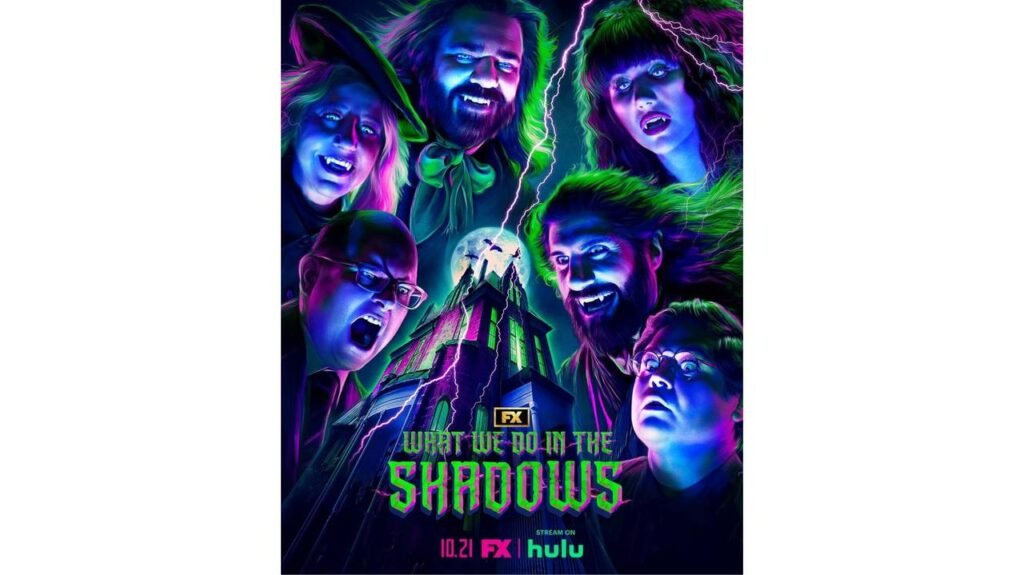
6. Gremlins (1984)
- Director: Joe Dante
- Synopsis: A young man receives a strange creature as a Christmas gift, but he accidentally violates three important rules, unleashing a horde of mischievous and destructive gremlins upon his small town.
- Why it’s great:
- Visual effects: The practical effects are still impressive today, bringing the gremlins to life with impressive detail and creativity.
- Family-friendly scares: While undeniably scary in places, the film maintains a playful and lighthearted tone, making it suitable for family viewing.
- Nostalgic charm: Gremlins has become a beloved holiday classic, evoking feelings of nostalgia and childhood wonder.
Gremlins (1984): A Timeless Tale of Terror and Merriment
A Blend of Frights and Fun
Gremlins, a 1984 American comedy horror film directed by Joe Dante, is a beloved classic that seamlessly blends elements of horror, comedy, and fantasy. Produced by Steven Spielberg under his Amblin Entertainment banner, the film tells the story of Billy Peltzer, a young man who receives a unique and seemingly harmless creature as a Christmas gift. However, Billy soon discovers that his new pet comes with a set of peculiar rules, the violation of which unleashes a horde of mischievous and destructive creatures upon his small town.
The Mogwai and Its Mayhem
The film begins with Billy’s father, Randall, on a business trip to Chinatown where he encounters a curious shopkeeper. Intrigued by a peculiar creature resembling a furry rodent, Randall purchases it as an unusual Christmas present for Billy. The shopkeeper, however, provides three crucial warnings:
- Never expose the creature to bright light.
- Never get it wet.
- Never feed it after midnight.
Billy names the creature Gizmo and quickly grows attached to it. Gizmo proves to be a playful and affectionate companion, but Billy’s friends, inadvertently breaking the first rule, accidentally splash water on Gizmo. This triggers a chain reaction, causing Gizmo to reproduce, spawning a swarm of small, mischievous creatures known as Gremlins.
The Gremlin Invasion
The Gremlins, driven by their mischievous nature, wreak havoc on the peaceful town of Kingston Falls. They engage in a series of destructive acts, including:
- Sabotaging the town’s power grid: Plunging the town into darkness and chaos.
- Infiltrating a movie theater: Projecting a horror film that drives the audience into a frenzy.
- Taking over the local bar: Indulging in excessive drinking and causing a riot.
- Attacking the town’s residents: Injuring and even killing several townspeople.
The Battle for Survival
As the Gremlin invasion intensifies, Billy and his girlfriend, Kate, must find a way to stop the creatures before they cause further destruction. They discover that the only way to kill a Gremlin is to expose it to bright light. With the help of Kate’s father, a local inventor, they devise a plan to lure the Gremlins to the town square and unleash a barrage of bright lights, effectively eliminating the threat.
Themes and Legacy
Gremlins is a film that resonates with audiences of all ages. It explores themes of responsibility, the dangers of unchecked desires, and the importance of following rules. The film also offers a satirical commentary on consumerism and the dangers of unchecked technological advancement.
The film’s success can be attributed to several factors, including:
- Innovative Special Effects: The film features groundbreaking practical effects, bringing the Gremlins to life with impressive detail and creativity.
- Engaging Characters: The characters are well-developed and relatable, with Billy and Kate emerging as likable protagonists.
- A Blend of Genres: The film masterfully blends elements of horror, comedy, and fantasy, creating a unique and unforgettable cinematic experience.
- Nostalgic Appeal: Gremlins has become a beloved holiday classic, evoking feelings of nostalgia and childhood wonder.
Gremlins remains a timeless and influential film that continues to entertain and frighten audiences of all ages. Its blend of humor, horror, and heartwarming moments has solidified its place as a beloved classic in the annals of cinematic history.
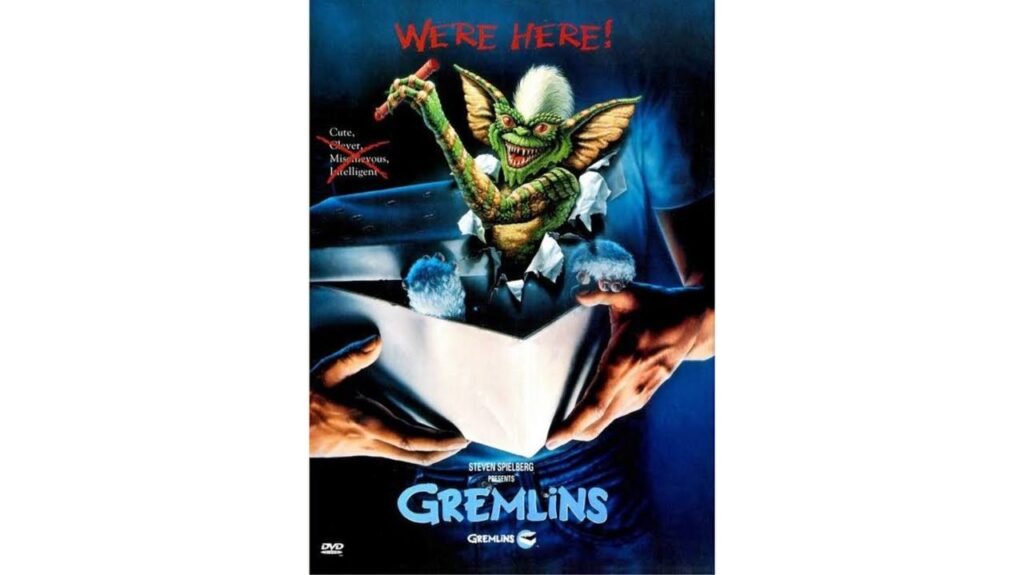
5. An American Werewolf in London (1981)
- Director: John Landis
- Synopsis: Two American backpackers are attacked by a werewolf in the English countryside, with one of them transforming into the monstrous creature.
- Why it’s great:
- Groundbreaking special effects: The werewolf transformation sequence is a groundbreaking piece of cinematic artistry, still impressive today.
- Dark humor: The film blends horror with dark humor, exploring themes of loneliness, guilt, and the fear of the unknown.
- Iconic status: An American Werewolf in London is a cult classic with a dedicated following, and its influence can be seen in countless horror comedies that followed.
An American Werewolf in London: A Howl of a Good Time
A Timeless Blend of Horror and Humor
John Landis’s “An American Werewolf in London” (1981) is a landmark film that seamlessly blends classic horror with dark humor. It’s a chilling and often hilarious journey into the world of lycanthropy, leaving an enduring mark on the genre.
The Plot:
The film follows two American college students, David Kessler (David Naughton) and Jack Goodman (Griffin Dunne), on a backpacking trip through the English countryside. Their idyllic excursion takes a terrifying turn when they are attacked by a mysterious creature on the moors. Jack is killed, while David survives but sustains horrific injuries.
Waking up in a London hospital, David begins to experience strange hallucinations and nightmares. He encounters the ghostly apparition of Jack, who warns him of the impending transformation that awaits him under the next full moon. As the moon waxes full, David grapples with his impending fate, experiencing bizarre physical changes and confronting the horrifying reality of his condition.
A Masterclass in Special Effects:
One of the most celebrated aspects of “An American Werewolf in London” is its groundbreaking special effects. The werewolf transformation sequence is a cinematic masterpiece, a chilling and unforgettable display of practical effects artistry. The meticulous attention to detail, from the subtle physical changes to the grotesque final transformation, remains awe-inspiring even today.
A Touch of Dark Humor:
While undoubtedly a horror film, “An American Werewolf in London” is infused with a dark and often morbid sense of humor. The film plays with classic horror tropes, subverting expectations and delivering unexpected comedic moments. The interactions between David and the ghostly Jack, for example, provide a darkly humorous counterpoint to the horror, offering a touch of levity amidst the terror.
Themes and Influences:
The film explores a variety of themes, including the fear of the unknown, the fragility of life, and the impact of trauma. It also delves into the anxieties of youth and the search for identity, reflecting the experiences of young people navigating the complexities of adulthood.
“An American Werewolf in London” has had a profound influence on subsequent horror films, particularly those in the creature feature and lycanthropy subgenres. Its innovative blend of horror and humor, combined with its groundbreaking special effects, has cemented its place as a classic of the genre.
A Lasting Legacy:
Decades after its release, “An American Werewolf in London” continues to captivate audiences with its chilling atmosphere, unforgettable imagery, and enduring blend of horror and humor. It remains a testament to the power of cinematic storytelling and a timeless masterpiece of the horror genre.
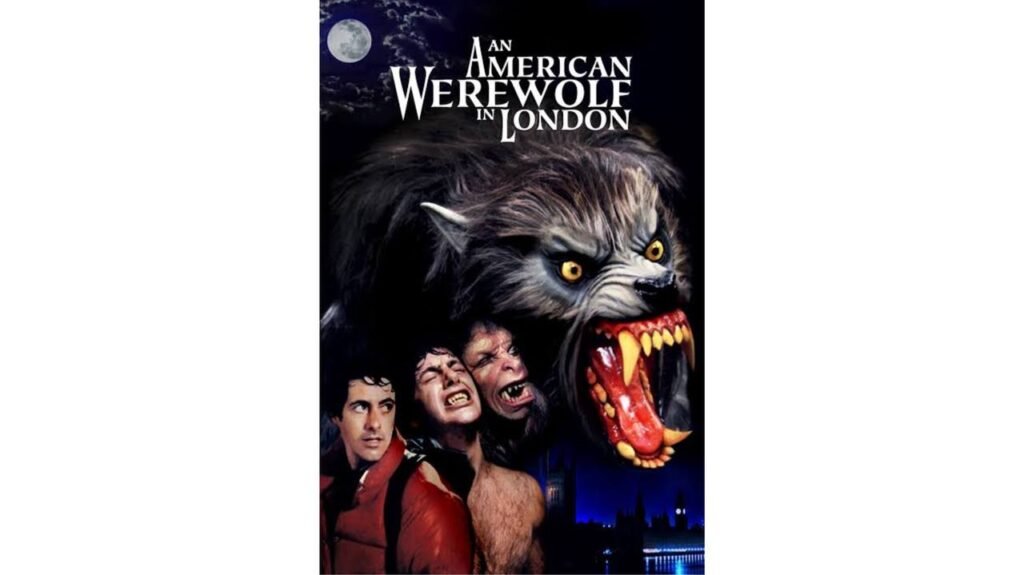
4. Tucker & Dale vs Evil (2010)
- Director: Eli Craig
- Synopsis: Two good-natured hillbillies are mistaken for murderous backwoods cannibals by a group of college students, leading to a series of increasingly absurd and tragicomic events.
- Why it’s great:
- Subverting expectations: The film brilliantly plays with horror movie clichés, turning the tables on the typical “dumb teenagers vs. hillbillies” scenario.
- Black comedy: The humor is dark and often morbid, pushing the boundaries of good taste while remaining consistently entertaining.
- Relentlessly absurd: The film escalates into increasingly ridiculous situations, culminating in a hilariously chaotic climax.
Tucker & Dale vs Evil: A Hilariously Subversive Take on Horror Tropes
“Tucker & Dale vs Evil” (2010) is a darkly comedic horror film that masterfully subverts expectations and delivers a fresh, insightful take on the classic “hillbilly horror” trope. Directed by Eli Craig, the film follows two affable backwoodsmen, Tucker and Dale, who are mistaken for murderous cannibals by a group of college students on a weekend camping trip.
A Twist on the Slasher:
The film brilliantly inverts the typical slasher film formula. Instead of the menacing hillbillies being the antagonists, they are portrayed as kind-hearted and genuinely harmless individuals. The true villains of the piece are the paranoid and judgmental college students, who misinterpret Tucker and Dale’s every action, leading to a series of tragicomic misunderstandings.
Black Comedy at its Finest:
“Tucker & Dale vs Evil” is a masterclass in black comedy. The film revels in the absurdity of the situation, with each death occurring through a series of unfortunate accidents, rather than intentional acts of violence. The humor is often dark and morbid, pushing the boundaries of good taste while remaining consistently entertaining.
Character Development:
Despite the over-the-top violence and dark humor, the film manages to develop its characters with surprising depth. Tucker and Dale, initially presented as stereotypical backwoodsmen, are revealed to be kind, gentle, and even somewhat naive individuals. The college students, while initially portrayed as the protagonists, are gradually revealed to be judgmental, selfish, and ultimately responsible for their own demise.
Visual and Technical Excellence:
The film is visually stylish, with a distinct aesthetic that complements the dark and comedic tone. The practical effects are impressive, with the gore and violence effectively executed without being overly gratuitous. The pacing is brisk and engaging, keeping the audience entertained throughout the film’s short runtime.
Cultural Impact:
“Tucker & Dale vs Evil” has garnered a dedicated cult following and is considered a modern classic of the horror-comedy genre. The film’s subversive approach and sharp wit have influenced countless filmmakers, inspiring a new wave of horror comedies that challenge conventions and offer fresh perspectives.
In Conclusion:
“Tucker & Dale vs Evil” is a must-watch for fans of horror, comedy, and genre-bending cinema. It’s a film that will stay with you long after the credits roll, leaving you pondering the dangers of prejudice and the importance of perspective.
Disclaimer: This analysis provides a comprehensive overview of “Tucker & Dale vs Evil.” Viewer discretion is advised as the film contains graphic violence and strong language.
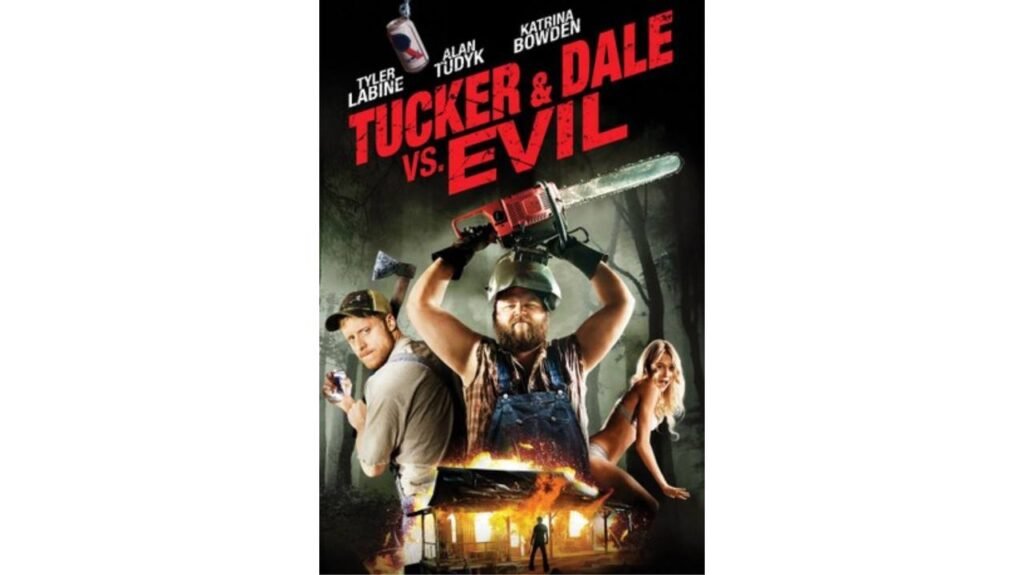
3. The Cabin in the Woods (2012)
- Directors: Drew Goddard, Joss Whedon
- Synopsis: A group of college friends head to a remote cabin in the woods for a weekend getaway, unaware that they are unwitting participants in a sinister game orchestrated by unseen forces.
- Why it’s great:
- Meta-commentary: The film cleverly deconstructs horror movie tropes, offering a fresh and insightful perspective on the genre.
- Unexpected twists: The plot takes numerous surprising turns, keeping viewers constantly guessing.
- Satisfyingly subversive: The film subverts expectations and delivers a darkly humorous and thought-provoking conclusion.
The Cabin in the Woods: A Deep Dive into Horror’s Meta-Textual Masterpiece
A Subversive Satire of Horror Tropes
“The Cabin in the Woods,” a 2012 horror-comedy masterpiece co-written by Joss Whedon and directed by Drew Goddard, is not your typical slasher flick. This film masterfully deconstructs and satirizes the conventions of the horror genre, offering a meta-commentary on audience expectations and the industry’s reliance on familiar tropes.
The Premise:
Five college students – the jock, the virgin, the slut, the fool, and the scholar – embark on a weekend getaway to a remote cabin deep in the woods. Unbeknownst to them, their every move is being monitored and manipulated by a team of technicians in a hidden underground facility. These technicians, led by Sitterson (Richard Jenkins) and Addy (Bradley Whitford), are tasked with ensuring that the students fulfill a specific set of archetypes and that the ensuing horror unfolds according to a pre-determined script.
A Calculated Game:
The film masterfully reveals the inner workings of this elaborate game, showcasing the technicians’ meticulous control over the students’ actions and the supernatural entities unleashed upon them. The students, oblivious to the machinations behind the scenes, become pawns in a ritual designed to appease ancient gods and prevent global catastrophe.
Subverting Expectations:
“The Cabin in the Woods” delights in subverting audience expectations. It plays with familiar horror tropes, such as the “final girl,” the “dumb jock,” and the “sex-crazed teens,” only to twist them in unexpected ways. The film revels in its own self-awareness, acknowledging the audience’s familiarity with horror clichés while simultaneously subverting them.
A Commentary on Audience Consumption:
The film’s most profound commentary lies in its exploration of the audience’s role in perpetuating horror tropes. The technicians reveal that the success of the ritual depends on the audience’s desire to see certain events unfold. They manipulate the situation to cater to the audience’s expectations, ensuring that the horror unfolds according to familiar and satisfying patterns. This meta-commentary raises thought-provoking questions about our own complicity in the consumption of violent entertainment.
A Darkly Humorous Masterpiece:
“The Cabin in the Woods” is not just a clever deconstruction of the horror genre; it’s also a darkly humorous and entertaining film. The dialogue is sharp and witty, and the performances are uniformly excellent. The film’s blend of horror, comedy, and social commentary creates a unique and unforgettable cinematic experience.
Conclusion:
Top 10 Best Horror Movies In World….click here
“The Cabin in the Woods” is a groundbreaking film that transcends the typical horror movie. It’s a smart, subversive, and entertaining commentary on the genre itself, challenging audiences to question their own expectations and the role they play in perpetuating the cycle of horror. This film is a must-see for any fan of horror, comedy, or cinema in general.
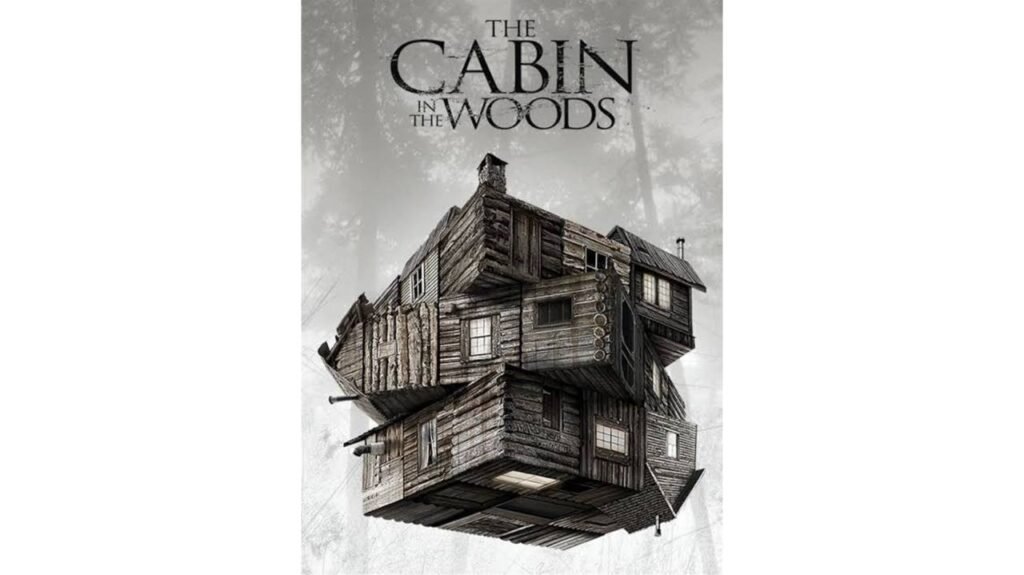
2. What We Do in the Shadows (2014)
- Director: Taika Waititi, Jemaine Clement
- Synopsis: A mockumentary following the lives of four vampires sharing a flat in Wellington, New Zealand, as they navigate modern life with all its awkward social situations and mundane chores.
- Why it’s great:
- Relatable: The vampires’ struggles with technology, dating, and flatmate disagreements are surprisingly relatable.
- Deadpan humor: The deadpan delivery and absurd situations create an irresistible comedic effect.
- Charming characters: The four vampires are distinct and endearing, each with their own quirks and personalities.
What We Do in the Shadows: A Deeper Dive
What We Do in the Shadows is a 2014 mockumentary horror comedy film written and directed by Jemaine Clement and Taika Waititi. The film follows the lives of four vampires who share a flat in Wellington, New Zealand, as they navigate modern life with all its awkward social situations and mundane chores.
A Unique Blend of Horror and Humor:
The film masterfully blends the tropes of traditional vampire lore with the mundane realities of modern life. It presents a hilarious and often absurd look at the daily struggles of these ancient beings as they grapple with issues like paying rent, doing the dishes, and dealing with noisy neighbors.
Meet the Flatmates:
- Viago: The suave and charming leader of the group, Viago is centuries old and desperately trying to maintain his youthful appearance. He is obsessed with modern music, particularly the “Unfamiliar” by Death from Above 1979.
- Deacon: The flamboyant and theatrical member of the group, Deacon is known for his extravagant capes and his obsession with the 18th century. He struggles to adapt to modern technology and often finds himself bewildered by everyday conveniences.
- Vladislav: The oldest and most dangerous of the group, Vladislav is a brooding and melancholic figure haunted by his past. He is prone to violent outbursts and struggles to control his bloodlust.
- Petyr: The newest member of the group, Petyr is a young and inexperienced vampire who is still learning the ropes of immortality. He is eager to please his flatmates but often makes clumsy mistakes.
The Arrival of Nick:
The arrival of Nick, a young hipster who is turned into a vampire by Petyr, throws the household into disarray. Nick struggles to adapt to his new undead existence, grappling with his thirst for blood and his newfound aversion to sunlight. He also clashes with his flatmates, who find his modern sensibilities and youthful energy to be both endearing and irritating.
A Day in the Life of a Vampire:
The film follows the vampires as they go about their daily lives, attending a “unlife” party, hunting for blood, and dealing with the challenges of modern living. We witness their struggles with technology, their attempts to fit in with human society, and their ongoing conflicts with werewolves, who are their sworn enemies.
Key Themes and Humor:
- The Absurdity of Immortality: The film satirizes the concept of immortality, highlighting the mundane and often frustrating aspects of living forever. The vampires are bored with their eternal existence and yearn for excitement and meaning in their lives.
- The Clash Between Old and New: The film explores the clash between the old and the new, as the ancient vampires struggle to adapt to the modern world and its ever-changing technology and social norms.
- Flatmate Dynamics: The film humorously depicts the dynamics of living with roommates, highlighting the petty squabbles, the shared responsibilities, and the occasional moments of camaraderie.
- Deadpan Humor: The film relies heavily on deadpan humor, with the vampires delivering their lines with a straight face, making their absurd situations even more hilarious.
Critical Acclaim and Impact:
What We Do in the Shadows was a critical and commercial success, praised for its sharp wit, original premise, and strong performances. It has since become a cult classic and spawned a successful television series, further expanding the world of these quirky vampires.
Conclusion:
What We Do in the Shadows is a unique and hilarious film that offers a fresh and insightful perspective on the vampire genre. It is a must-watch for fans of horror comedy, offering a blend of dark humor, witty dialogue, and memorable characters. The film’s success has paved the way for a new wave of vampire-themed comedies, proving that there is still plenty of life left in this classic horror icon.
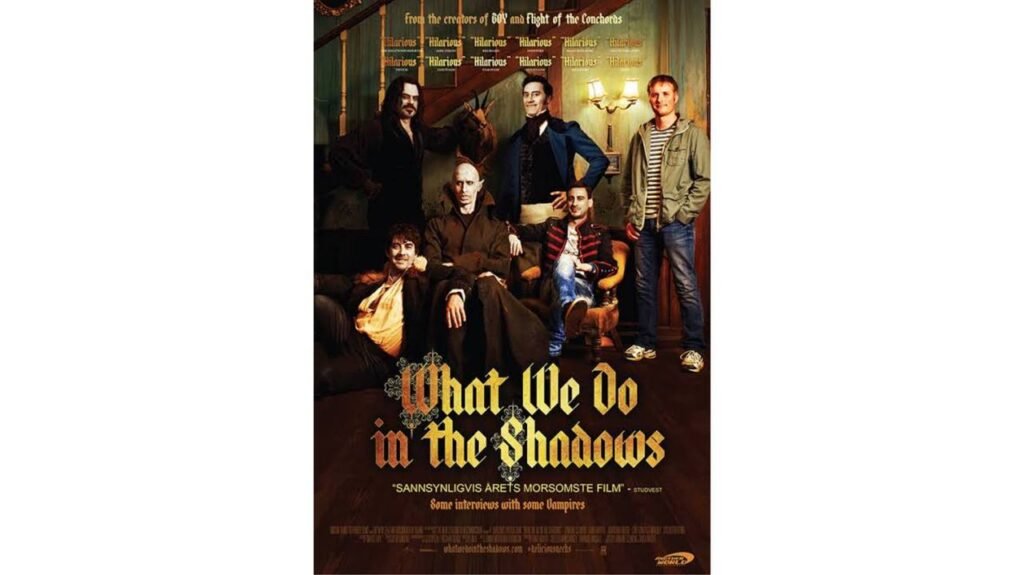
1. Shaun of the Dead (2004)
- Director: Edgar Wright
- Synopsis: A hilarious and heartwarming take on the zombie apocalypse, following Shaun and his friends as they navigate the undead hordes while trying to save their local pub.
- Why it’s great:
- Sharp wit: The dialogue is razor-sharp, filled with witty banter and quotable lines.
- Pacing: Edgar Wright’s signature fast-paced editing and visual style keep the energy high throughout.
- Heartfelt: Beneath the gore and humor lies a touching story about friendship and finding your place in the world.
Shaun of the Dead: A Deeper Dive into the Zombie Rom-Com
Shaun of the Dead (2004) isn’t just a zombie movie; it’s a hilarious and heartwarming ode to British life, friendship, and the importance of facing your fears. Directed by Edgar Wright and co-written by Wright and Simon Pegg, the film masterfully blends horror, comedy, and social commentary, leaving an enduring impact on the genre.
A Day in the Life of Shaun:
The film follows Shaun, a directionless electronics salesman stuck in a rut. His life is a monotonous cycle of work, pub visits with his best friend Ed, and a strained relationship with his girlfriend, Liz. Shaun’s attempts to impress Liz with a romantic gesture backfire spectacularly, and he’s left feeling more lost than ever.
The Zombie Apocalypse:
Suddenly, amidst the mundane chaos of Shaun’s life, a zombie apocalypse erupts in London. Initially oblivious to the rising threat, Shaun and Ed continue their pub crawl, stumbling upon the first signs of the undead. The initial disbelief and confusion quickly give way to a desperate struggle for survival.
A Plan for Survival (and Love):
Shaun, with Ed by his side, formulates a plan to survive the zombie onslaught. Their mission: to rescue Shaun’s mother, Barbara, and Liz from their respective homes and regroup at the Winchester pub, their safe haven.
The Journey:
The journey to the Winchester is fraught with peril. Shaun and Ed encounter hordes of shambling zombies, navigate perilous obstacles, and face their own personal demons along the way. The film masterfully intertwines the zombie horror with Shaun’s personal journey of self-discovery.
Facing Fears and Finding Redemption:
Through the chaos and carnage, Shaun begins to confront the shortcomings in his life. He learns to communicate with his mother, mend his relationship with Liz, and finally take responsibility for his own happiness. The zombie apocalypse, ironically, becomes a catalyst for personal growth and redemption.
A Love Letter to British Culture:
- Pub Culture: The film pays homage to quintessential British pub culture, capturing the essence of local pubs as social hubs and safe havens.
- Everyday Life: The film realistically portrays the mundane aspects of everyday life in London, from the daily commute to the frustrations of modern living.
- Humor: The humor is quintessentially British, dry, witty, and often self-deprecating, resonating with audiences worldwide.
Technical Brilliance:
- Fast-Paced Editing: Edgar Wright’s signature fast-paced editing style keeps the energy high and the action sequences exhilarating.
- Visual Style: The film is visually stylish, with vibrant colors and dynamic camera work that complement the comedic tone.
- Music: The soundtrack features a perfect blend of classic rock and contemporary indie music, enhancing the film’s atmosphere and mood.
Cultural Impact:
- Redefining the Zombie Genre: Shaun of the Dead revitalized the zombie genre, injecting a much-needed dose of humor and self-awareness.
- Critical Acclaim: The film was a critical and commercial success, earning praise for its originality, humor, and performances.
- Cult Following: Shaun of the Dead has achieved cult classic status, with fans appreciating its witty dialogue, memorable characters, and enduring themes.
Top 10 Comedian Movies In Bollywood…click here
Conclusion:
Shaun of the Dead is more than just a zombie movie; it’s a hilarious and heartwarming coming-of-age story that resonates with audiences of all ages. The film’s clever writing, masterful direction, and unforgettable performances have cemented its place as a modern classic and a must-watch for fans of horror comedy.
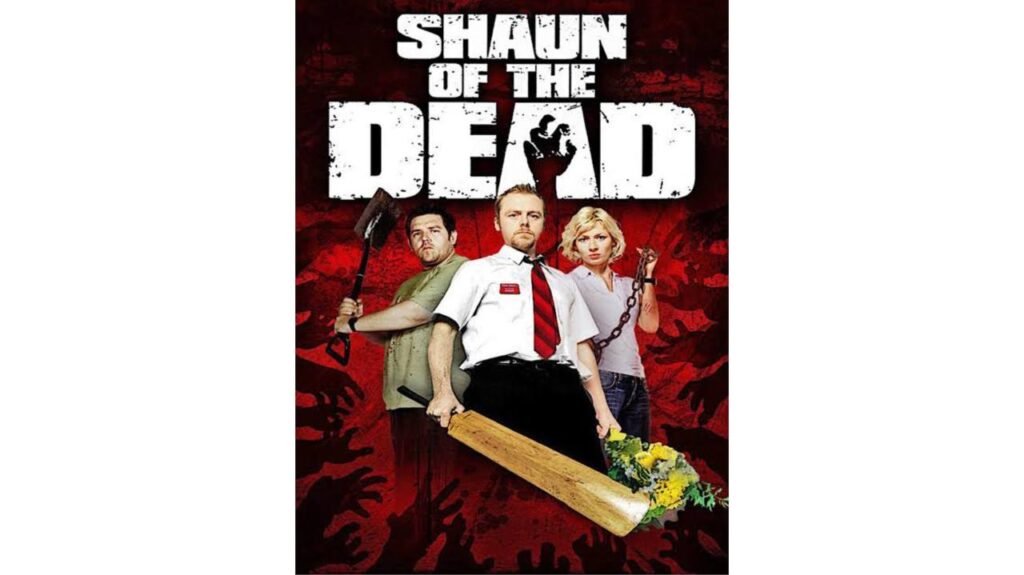
Conclusion:
This list provides a glimpse into the diverse and exciting world of horror comedy. These films masterfully blend the thrills of horror with the laughter of comedy, creating unique and unforgettable cinematic experiences. Whether you’re a seasoned horror fan or simply looking for a good laugh, these films are sure to entertain and terrify in equal measure.
Disclaimer: This list is subjective and represents just a small selection of the many excellent horror comedies available.
Here is the list of Top 10 Best Movie:- horror comedian movies In World
FAQs
Q: What exactly defines a horror-comedy (or “hor-com”) movie?
A: Horror-comedy blends elements of the horror and comedy genres. It aims to scare or create suspense while simultaneously eliciting laughter through humor, often using dark humor, slapstick, or witty dialogue. The balance between horror and comedy can vary significantly.
Q: What are some common tropes or themes found in horror-comedy films?
A: Common tropes include: Self-aware characters who acknowledge the horror movie setting.
Over-the-top gore or violence played for comedic effect.
Parodies or homages to classic horror films.
Characters reacting to terrifying situations in humorous ways.
The juxtaposition of the mundane with the supernatural.
Q: Are horror-comedy movies suitable for all audiences?
A: Not necessarily. While the comedic elements can lighten the mood, these films often still contain elements of horror, such as violence, gore, jump scares, and frightening imagery. Viewer discretion is advised, especially for younger audiences or those sensitive to horror content. Check ratings and reviews before watching.
Q: What are some examples of subgenres within horror-comedy?
A: There are several subgenres, including: Zombie comedy (e.g., Shaun of the Dead)
Monster comedy (e.g., Tremors)
Slasher comedy (e.g., Tucker & Dale vs Evil)
Parody horror (e.g., Scary Movie)
Dark comedy with horror elements (e.g., What We Do in the Shadows)
Q: Where can I find and watch these horror-comedy movies?
A: Many horror-comedy films are available on various streaming platforms (like Netflix, Hulu, Amazon Prime Video), for rent or purchase on digital platforms (like iTunes, Google Play Movies), and on physical media (DVDs, Blu-rays). Availability may vary depending on your region.
